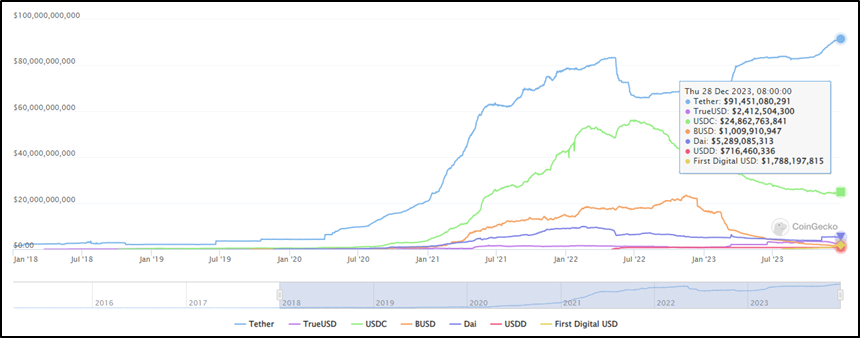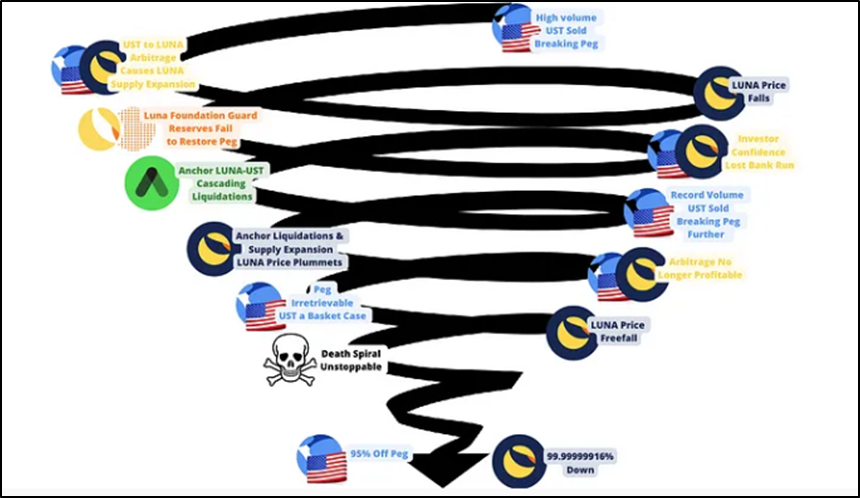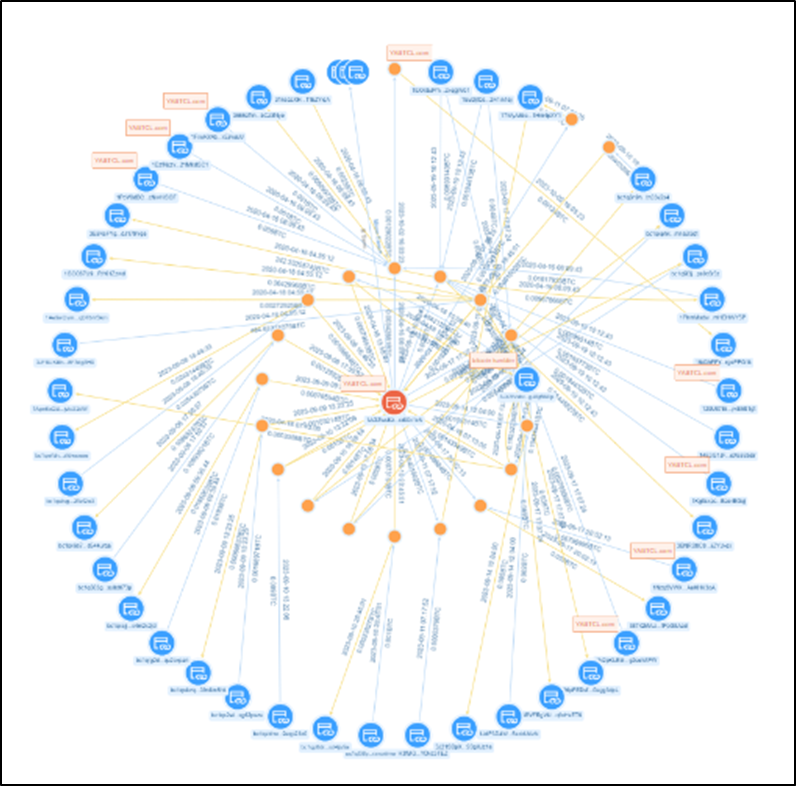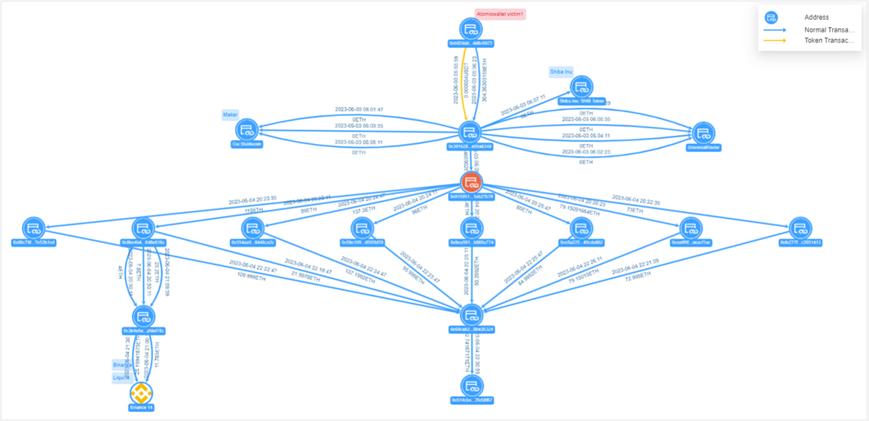1. Overview of Stablecoins
As we all know, the price of cryptocurrency is extremely unstable. In order to have a reasonable price measurement standard in the cryptocurrency market and lay the foundation for the liquidity of various cryptocurrencies, stablecoins came into being. It is designed to maintain a stable value, achieved by anchoring the value of a stable asset such as the US dollar. As a result, the value of a stablecoin is typically held at a fixed 1:1 exchange rate with the U.S. dollar, euro, yuan, or other assets such as gold.
In addition to their value anchoring characteristics, stablecoins also play an important role as a means of payment, allowing users to make payments and transfers conveniently. Since the value of stablecoins is relatively stable, it is easier for users to conduct commercial transactions and payments. As the base currency for OTC, DeFi and CeFi, stablecoins provide users with more financial services and product choices.
According to the mechanism and issuance method behind stablecoins, they can be divided into the following four categories:
(1) Centralized stable currency based on legal currency reserves
The value of such stablecoins maintains a fixed 1:1 exchange rate with fiat currencies (such as US dollars, euros, etc.). Issuers usually hold an equal amount of fiat currency reserves in bank accounts to ensure the value of the stablecoin. For example, Tether (USDT) and USDC (USD Coin) are representatives of centralized institutions. USDT has the highest liquidity and its market value has exceeded US$92 billion.
(2) Decentralized stable currency based on crypto asset mortgage
This type of stablecoin is decentralized, uses innovative solutions, is built on blockchain protocols, and is more secure and transparent. Also known as collateralized stablecoins, their asset backing typically comes from other cryptocurrencies, such as Ethereum or Bitcoin, to keep their value stable. MakerDAOs DAI is a typical example. It is generated through the over-collateralization mechanism and is very popular among DeFi protocols.
(3) Decentralized algorithm stable currency
It is one of the decentralized stable currency types. Its value is automatically adjusted by the algorithm without collateral. It uses market demand and supply to maintain its own fixed price. Ampleforth is an algorithm-based stablecoin that uses an elastic supply mechanism to automatically adjust supply based on market demand.
(4) Stable currency based on hybrid mechanism
This type of stablecoin combines the characteristics of the above different mechanisms to provide a more stable value. For example, Frax combines algorithmic and fiat currency reserves, using a hybrid stablecoin mechanism that is supported by part of the fiat currency reserves and the other part manages the supply through algorithms to maintain price stability.
In general:
Centralized stablecoins solve the value anchoring problem of virtual assets, link digital assets with physical assets (such as U.S. dollars or gold), stabilize their value, and at the same time solve the access problem of virtual assets in a regulatory environment, providing users with A more reliable way to store and trade digital assets. However, they usually rely on issuance and management by centralized institutions, and there are financial audit risks and regulatory risks on the part of the issuer.
The decentralization characteristics of decentralized stablecoins provide a more free and transparent way for the development of the cryptocurrency market, using transparent and verifiable smart contract codes to build market trust, but they also face challenges such as hacker attacks and governance risks.
2. On-chain data analysis
Since Tether launched the first stablecoin USDT in 2014, various types of stablecoins have emerged in the market, such as USDC, DAI, BUSD, etc. The total market value of stablecoins has gradually grown since 2018, and began to rise rapidly in mid-2020, continuing until it reached its peak on April 7, 2022, with the total market value reaching US$182.65 billion. However, the market trend subsequently declined, and as of now (December 28, 2023), the total market capitalization has fallen back to $128.77 billion.
Figure: Stablecoin Market Cap (2018.2.1 – 2023.12.28)

Figure: Top Stablecoins Market Cap (2018.1.1 – 2023.12.28)
In terms of market share, USDT has always occupied a leading position. Since the beginning of 2020, the top five major stablecoin market capitalization coins have been USDT, USDC, BUSD, DAI, and TrueUSD. However, by June 2023, as Binance was sanctioned, BUSD’s market capitalization dropped significantly and it gradually lost its top five status. Meanwhile, First Digital USD has grown rapidly since its launch on June 1, 2023, and as of December 14, its market capitalization surpassed BUSD to become the fifth largest stablecoin. The following are relevant data statistics such as market capitalization, trading volume, supply, and user volume of the top five stablecoins:
Figure: TOP 5 Stablecoins Market Cap, Volume and Circulating Supply. Data as of 2023/12/28
Figure: USDT trading volume, number of transactions, and number of users in the past 30 days, data as of 2023/12/28
Figure: USDC trading volume, number of transactions, and number of users in the past 30 days, data as of 2023/12/28
Figure: DAI transaction volume, number of transactions, and number of users in the past 30 days, data as of 2023/12/28
3. Security and Risks of Algorithmic Stablecoins
Algorithmic stablecoins use a mechanism similar to shadow banking. Unlike traditional stablecoins, algorithmic stablecoins do not require a centralized institution to maintain their stability. Instead, they use algorithms to adjust the supply and demand relationship in the market to ensure that prices remain within a certain range. . However, this form of currency also faces a series of challenges, including risks such as insufficient market liquidity and black swan events. The value of algorithmic stablecoins is not entirely supported by external reserves, but uses algorithm-based market mechanisms to regulate supply and demand to maintain price stability.
In recent years, algorithmic stablecoins have often collapsed due to death spiral problems, which are mainly reflected in the following aspects:
(1) Supply and demand imbalance
When market demand for an algorithmic stablecoin declines, its price may fall below its target value, causing the issuer to need to burn or buy back part of the circulating supply to restore balance. This may further reduce market confidence and demand, causing a vicious run. The Luna/UST collapse is the most typical example.
(2) Governance risk
Since the operation of algorithmic stablecoins relies on smart contracts and community consensus, there may be governance risks, such as code defects, hacker attacks, price manipulation, etc.
(3) Legal supervision
Because algorithmic stablecoins are not backed or anchored by physical assets, they face additional legal regulatory challenges and uncertainty. It is expected that more countries or regions will restrict or ban the use of algorithmic stablecoins in the future.
(4) Case analysis: Luna/UST collapse
Business Model: Algorithmic Stablecoin (UST/Luna) and High Interest Rate (Anchor):
The core design idea of the Terra ecosystem is around how to expand the usage scenarios and payment needs of the stablecoin UST. The operation of UST adopts a dual-Token design, Luna: a token for governance, pledge and verification, and UST: a stablecoin pegged to the native US dollar. The simple understanding is that every time a UST is minted, one dollar worth of Luna must be burned, and Luna helps maintain the peg between UST and the U.S. dollar through an arbitrage mechanism: if the price of $UST is > 1 $, there is a chance to destroy $Luna, Mint $UST and take the difference from the peg as profit; if UST is< 1 $, you can burn $UST for $Luna to restore the peg, buy 1 UST for less than $1 and get $1 worth of Luna, then sell $Luna for a profit.
Anchor Protocol (hereinafter referred to as Anchor) is a DeFi platform officially launched by Terra in March 2021. It is essentially Lending, similar to Compund. But what makes Ancho special is its extremely high APY (Annual Percentage Yield), which has always been maintained at around 20%. Stimulated by high annual growth, user demand for UST has skyrocketed, which is also the core of USTs business. In the Terra ecosystem, Anchor acts as a state-owned bank and promises an ultra-high demand yield of 20% to absorb public deposits (in the form of UST).

Income and expenditure model: living beyond your means creates hidden dangers:
Anchors main income comes from borrowing interest + PoS reward income of borrowing collateral (currently bLUNA and bETH) + liquidation penalty; Anchors main expenditure is about 20% annualized deposit interest, and Anchor itself also provides borrowers with relatively high benefits. In order to maintain the price of ANC tokens due to high ANC token subsidies, Anchor also faces additional ANC token price maintenance costs, which is to solve the problem of selling pressure on ANC tokens.
This is the income and expenditure model of UST and Luna. Based on the current size of UST and Luna, they need to bear an additional operating cost of about one billion US dollars per year. Anchor alone is obviously unable to bear this expense. Therefore, in February 2022, when Anchors reserve pool was about to be exhausted, LFG announced an allocation of 450 million UST for Anchor to replenish its reserve pool. This confirms one point: Anchor is different from other lending protocols. It is essentially an integral part of Terras planned economy. Its current business operations are not for the pursuit of profit, but are funded by Terra officials to provide subsidies for the expansion of UST. Scenario-based products.
The creation of the death spiral:
Through the above analysis, it can be seen that the complete logic of Terra is: create its own scenarios through Anchor and shape the demand for stablecoins; demand drives the scale of UST’s casting, attracting users to enter the market; users continue to enter the market, creating ecological data performance (TVL, address number, number of projects, etc.) and gradually push up the price of Luna; project parties or foundations cash out funds through Luna and provide subsidies to maintain high annualized returns, and this cycle continues.
If the above cycle is stable, UST is the engine of Luna, and Luna is the stabilizer of UST. More Web3 projects and users will pour in, and the two will interact and form a positive spiral when the trend is good.
But when Luna’s market value relative to stablecoins becomes lower and the depth of transactions decreases, there will be insufficient collateral, the risk of stablecoins de-anchoring will increase, and the cost of maintaining consensus will be higher, leading to a death spiral. For example, when the market as a whole plummets and Luna is not immune, or when someone can block the price of Luna, a death spiral will appear.

How high is the threshold for a death spiral to occur, and how high is the risk?
Of course, the project party is aware of the importance of maintaining circulation and subsidy sources, and is also taking measures to increase production reserves. Anchor is adding new collateral assets: bLuna, bETH, wasAVAX, bATOM, which will also help increase Anchor’s profits. Introducing the anchor dynamic rate, according to the proposal, the anchor yield will decrease at a rate of 1.5% per month, and the minimum APY is set to 15%, which will be reached within 3 months, but if the APY of Anchor is lower than people hope, people will be disappointed with UST And the demand for Luna will fall, the demand for UST will become smaller, more Luna will be minted, and the price of Luna will fall.
Therefore, the emergence of the death spiral may come from three situations: an overall decline in market conditions, a decline in Anchor APY, and a targeted blockade of Lunas price. At present, it seems that the emergence of Terras death spiral is almost inevitable.
4. Analysis of black U black ash production
"Black and gray products"Usually refers to industrial chains that are illegal or even harmful to society. These industrial chains often violate legal regulations and involve activities such as fraud, illegal transactions, and smuggling. In recent years, more and more black and gray industries have used cryptocurrencies, especially the stable currency USDT, to illegally raise funds or launder money. The emergence of black U has also seriously undermined the safe development of the stable currency ecosystem. It mainly includes the following aspects:
(1) Online gambling
Online gambling is a branch of black industry with serious social harm. It involves the operation of online gambling platforms, network technology, payment systems, advertising and promotion and other aspects. Black and gray properties will create seemingly legitimate gambling websites or applications to attract players to register and participate in gambling activities, and promote their gambling platforms through various methods, including malicious advertisements, spam, etc., to expand the user base. Cryptocurrencies are a popular method of payment because they provide a relatively anonymous method of payment, making online gambling more difficult to track. Before committing illegal and criminal activities, black and gray criminals will create or purchase virtual identities, which in cryptocurrency are blockchain addresses. Fund transactions conducted through gambling platforms may be used to launder money and cover up illegal gains.

Figure: Transaction graph analysis of an online gambling address 1 AGZws…x 1 cN
(2) “Benchmarking” platform
"running score"Usually refers to the behavior of improving the performance test scores of software and hardware through some means. The black and gray USDT benchmark fraud is a fraud method disguised as money laundering. The platform generally claims to be an order-taking platform for laundering USDT funds involved, but in fact it is It is an investment scam. Once participants invest a large amount of USDT, the platform will refuse to return it for various reasons.
(3) Ransomware
Ransomware attacks are a serious problem in current cyberspace security. It is usually spread via phishing emails or malicious links, combined with social engineering attacks to trick users into clicking and downloading infected computers. After the victims data is encrypted, the ransomware typically displays a ransom message demanding a certain amount of ransom in order to obtain the decryption key. Ransoms are often required to be paid in cryptocurrency, such as Bitcoin, to increase the anonymity of the payment. Because financial institutions and other key sectors manage and store large amounts of critical data and services, they have become prime targets for ransomware attacks. In November 2023, ICBC Financial Services (ICBCFS), a wholly-owned subsidiary of ICBC in the United States, was attacked by the ransomware LockBit, which had a very negative impact. The picture below is the on-chain transaction hash map of a LockBit ransom payment address.

Figure: LockBit’s on-chain transaction hash map of a ransom payment address
(4) Terrorism
Terrorists use cryptocurrencies to raise funds and launder money to avoid monitoring and legal investigations by traditional financial institutions. Its anonymity and decentralized nature make it a tool that some terrorist organizations may exploit. Raising funds, transferring funds, and cyber hacking are ways terrorist groups may exploit cryptocurrencies. For example, Ukraine has used cryptocurrencies for cryptocurrency fundraising, and Russia has used cryptocurrencies to circumvent SWIFT sanctions. In October 2023, Tether (USDT) froze 32 addresses related to terrorism and war in Israel and Ukraine. These addresses held a total of 873,118.34 USDT.
(5) Money laundering
Due to the anonymity and difficulty of tracking cryptocurrencies, they are often used by criminals for laundering. According to statistics and on-chain risk labels, more than half of the black U assets are related to black and gray assets, and most of them are used for money laundering. Take the North Korean hacker group Lazarus Group as an example. They have completed the transfer and laundering of more than $1 billion in assets in recent years. Their money laundering model is usually as follows:
Multiple accounts can separate accounts and transfer assets in multiple small amounts, making tracking more difficult.
Create a large number of counterfeit currency transactions and increase the difficulty of tracking. Taking the Atomic Wallet incident as an example, 23 of the 27 intermediate addresses were counterfeit currency transfer addresses. A recent analysis of the Stake.com incident also found that similar technology was used, but this was not the case in the previous Ronin Network and Harmony incidents. Interference technology shows that Lazarus’ money laundering technology is also upgrading.
More on-chain methods (such as Tonado Cash) are used for currency mixing. In early incidents, Lazarus often used centralized exchanges to obtain start-up funds or conduct subsequent OTC. However, recently, centralized exchanges are used less and less, and even It can be considered that they are trying to avoid using centralized exchanges, which may be related to several recent sanctions.

Figure: Atomic Wallet fund transfer view
As illegal activities and other illegal activities utilizing cryptocurrencies continue to increase, the supervision of cryptocurrencies, especially stability, is particularly important.
5. Stablecoin supervision
Centralized stablecoins are issued and managed by centralized institutions, so the issuing institution needs to have certain strength and credibility. To ensure transparency and credibility, issuers should accept registration, filing, supervision and audit by regulatory agencies. In addition, stablecoin issuers should ensure a stable exchange ratio with fiat tokens and disclose relevant information in a timely manner. Regulators should require regular audits of stablecoin issuers to ensure the safety and adequacy of their reserve funds. At the same time, a risk monitoring and early warning mechanism should be established to detect and respond to possible risks in a timely manner.
Decentralized stablecoins use algorithms to adjust the total amount of currency in the market and determine prices based on supply and demand. They have high transparency, but are relatively difficult to regulate. Vulnerability inspection of algorithms, risk avoidance in extreme situations, and how to participate in community governance will become the main problems for supervision.
In 2019, Libras issuance plan attracted global market attention to stablecoins, and financial risk issues related to stablecoins were gradually exposed. The Global Stablecoin Assessment Report released in October of the same year officially proposed the concept of global stablecoins for the first time. , and pointed out its potential impact on financial stability, monetary sovereignty, consumer protection and other aspects.
Subsequently, the G20 commissioned the Financial Stability Board (FSB) to review the Libra project, and issued two regulatory recommendations on global stablecoins in April 2020 and February 2021. Under the FSB regulatory recommendations, some countries and regions have also proposed their own regulatory policies for stablecoins. Some countries are already strengthening the supervision of stablecoins, such as the United States Draft Stablecoin Payment Act, the regulatory policies of Hong Kong and Singapore, and the European Union. The Crypto Asset Market Regulation (MiCA), etc.
The Draft Stablecoin Payment Act released by the US regulatory authorities in April 2023 stipulates the conditions for the issuance and requirements of payment stablecoins, with special emphasis on being linked to legal tender or other highly liquid assets at a ratio of 1:1, which must be Request permission from the Board of Governors of the Federal Reserve System within 90 days, subject to audit and reporting. And the reform bill gives the Board of Governors of the Federal Reserve System emergency intervention and penalty powers. This bill not only reflects the U.S. government’s emphasis on the stable currency market, but also shows the U.S. government’s support and encouragement for crypto innovation.
The Hong Kong government discussed cryptocurrency and issued a summary in January 2023. The focus was to include cryptocurrency activities in supervision and stipulate the scope and requirements of supervision. It also elaborated on the principles of differentiated supervision and emphasized the relationship with Maintain communication and coordination between international organizations and other jurisdictions.
Singapore released the conclusions of a consultation paper on the regulatory framework for stablecoins in August 2023. On the one hand, the revision of historical regulatory scope, reserve management, capital requirements, information disclosure and other aspects of rules and regulations has established the final framework and emphasized differentiated supervision; on the other hand, the Payment Services Law and related regulations have been revised to strengthen cooperation with international supervision. Department coordination and communication.
The European Council, composed of government ministers from 27 EU member states, approved the Cryptoasset Market Regulation (MiCA) in May 2023. The draft was proposed by the European Commission in 2020 and will be implemented in 2024. MiCA mainly includes topics in three directions: one is the issuance rules for crypto assets, which imposes multiple requirements on issuers of various crypto assets and is a more complex set of rules for issuance, authorization, governance and prudential requirements; the second is crypto assets Service Provider (CASP): requires authorization from the competent authority and applies to financial companies under the Markets in Financial Instruments Regulation II (MiFID II); the third direction is the rules to prevent abuse of the crypto asset market.
The United States currently maintains a lead in cryptocurrency regulation, and its Draft Stablecoin Payments Act is expected to become the worlds first formal legislation specifically regulating stablecoins. Policies in other regions such as Hong Kong and Singapore will take time to settle into formal regulations. There are differences in the supervision of stablecoins in various countries, and the legislative process is also at different stages. Relevant institutions or operators should always assess risks and adjust their business models in accordance with applicable laws and regulations to comply with relevant regulations on stablecoins and avoid potential compliance risks.










